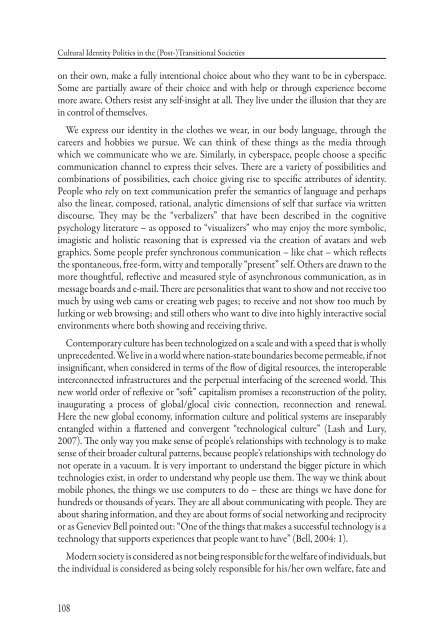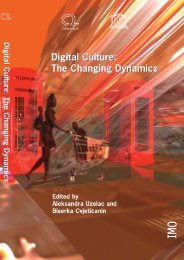free download in pdf format - Culturelink Network
free download in pdf format - Culturelink Network
free download in pdf format - Culturelink Network
You also want an ePaper? Increase the reach of your titles
YUMPU automatically turns print PDFs into web optimized ePapers that Google loves.
Cultural Identity Politics <strong>in</strong> the (Post-)Transitional Societies<br />
on their own, make a fully <strong>in</strong>tentional choice about who they want to be <strong>in</strong> cyberspace.<br />
Some are partially aware of their choice and with help or through experience become<br />
more aware. Others resist any self-<strong>in</strong>sight at all. Th ey live under the illusion that they are<br />
<strong>in</strong> control of themselves.<br />
We express our identity <strong>in</strong> the clothes we wear, <strong>in</strong> our body language, through the<br />
careers and hobbies we pursue. We can th<strong>in</strong>k of these th<strong>in</strong>gs as the media through<br />
which we communicate who we are. Similarly, <strong>in</strong> cyberspace, people choose a specifi c<br />
communication channel to express their selves. Th ere are a variety of possibilities and<br />
comb<strong>in</strong>ations of possibilities, each choice giv<strong>in</strong>g rise to specifi c attributes of identity.<br />
People who rely on text communication prefer the semantics of language and perhaps<br />
also the l<strong>in</strong>ear, composed, rational, analytic dimensions of self that surface via written<br />
discourse. Th ey may be the “verbalizers” that have been described <strong>in</strong> the cognitive<br />
psychology literature – as opposed to “visualizers” who may enjoy the more symbolic,<br />
imagistic and holistic reason<strong>in</strong>g that is expressed via the creation of avatars and web<br />
graphics. Some people prefer synchronous communication – like chat – which refl ects<br />
the spontaneous, <strong>free</strong>-form, witty and temporally “present” self. Others are drawn to the<br />
more thoughtful, refl ective and measured style of asynchronous communication, as <strong>in</strong><br />
message boards and e-mail. Th ere are personalities that want to show and not receive too<br />
much by us<strong>in</strong>g web cams or creat<strong>in</strong>g web pages; to receive and not show too much by<br />
lurk<strong>in</strong>g or web brows<strong>in</strong>g; and still others who want to dive <strong>in</strong>to highly <strong>in</strong>teractive social<br />
environments where both show<strong>in</strong>g and receiv<strong>in</strong>g thrive.<br />
Contemporary culture has been technologized on a scale and with a speed that is wholly<br />
unprecedented. We live <strong>in</strong> a world where nation-state boundaries become permeable, if not<br />
<strong>in</strong>significant, when considered <strong>in</strong> terms of the flow of digital resources, the <strong>in</strong>teroperable<br />
<strong>in</strong>terconnected <strong>in</strong>frastructures and the perpetual <strong>in</strong>terfac<strong>in</strong>g of the screened world. Th is<br />
new world order of reflexive or “soft ” capitalism promises a reconstruction of the polity,<br />
<strong>in</strong>augurat<strong>in</strong>g a process of global/glocal civic connection, reconnection and renewal.<br />
Here the new global economy, <strong>in</strong><strong>format</strong>ion culture and political systems are <strong>in</strong>separably<br />
entangled with<strong>in</strong> a flattened and convergent “technological culture” (Lash and Lury,<br />
2007). Th e only way you make sense of people’s relationships with technology is to make<br />
sense of their broader cultural patterns, because people’s relationships with technology do<br />
not operate <strong>in</strong> a vacuum. It is very important to understand the bigger picture <strong>in</strong> which<br />
technologies exist, <strong>in</strong> order to understand why people use them. Th e way we th<strong>in</strong>k about<br />
mobile phones, the th<strong>in</strong>gs we use computers to do – these are th<strong>in</strong>gs we have done for<br />
hundreds or thousands of years. Th ey are all about communicat<strong>in</strong>g with people. Th ey are<br />
about shar<strong>in</strong>g <strong>in</strong><strong>format</strong>ion, and they are about forms of social network<strong>in</strong>g and reciprocity<br />
or as Geneviev Bell po<strong>in</strong>ted out: “One of the th<strong>in</strong>gs that makes a successful technology is a<br />
technology that supports experiences that people want to have” (Bell, 2004: 1).<br />
Modern society is considered as not be<strong>in</strong>g responsible for the welfare of <strong>in</strong>dividuals, but<br />
the <strong>in</strong>dividual is considered as be<strong>in</strong>g solely responsible for his/her own welfare, fate and<br />
108



